
In June 2022, a tweet that reveals the stunning hourly salary charged by Move developers has gone viral on SNS platforms, which tempted many developers and institutional investors. Just recently, Move-based public chains received investment from many top institutions, which sparked heated discussions, and the high developer salary once again put the crypto spotlight on public chains with the Move language at the center of their narratives.
Aptos, SUI, and Linera are three Meta-related public chains that share similar narratives and developer backgrounds. In particular, Aptos and SUI have attracted much attention with their strong investor line-up and developer background. Compared to SUI, Aptos is more developer-friendly and was launched at an earlier date, attracting many project teams to start building applications on the chain. Today, we will check out the native projects on Aptos, a public chain “born with a silver spoon in its mouth”.
I. Infrastructures
1. Martian Wallet: http://martianwallet.xyz/
Martian, an early web-based wallet on Aptos, supports Google extensions and has recorded over 100,000 downloads. The wallet offers extensive application scenarios in the Aptos ecosystem and supports many Aptos-based protocols. Martian’s fast interactions and ease of use make it a beginner-friendly crypto wallet.
2. Zaptos: https://www.zaptos.finance/
Zaptos is a liquid staking protocol that allows users to earn returns by staking assets on Aptos. With the protocol, users stake APT and get stAPT at a 1:1 ratio. Like APT, stAPT can also be used to earn returns on other Aptos-based protocols. In addition, users can stake ZAP, the governance token of Zaptos, to vote on key parameters such as the rate. To date, the protocol’s basic rate stands at 10%, and all proceeds are distributed to node operators and Zaptos’ DAO and treasury. The overall design of Zaptos bears great resemblances to that of Lido, and the only difference between them is the blockchain on which they are based. The Aptos testnet is now live, and users can build nodes to receive airdrop rewards on the testnet. Zaptos has lowered the entrance threshold while ensuring the security and usability of users’ assets, which makes it a valuable infrastructure within the whole Aptos ecosystem.
At the moment, the protocol already supports tokens on the testnet. That said, the project lacks Lido’s market expectation created by the Merge. APT’s built-in consensus is Byzantine Fault Tolerance, and the difficulty of building nodes on Zaptos has nothing to do with the number of tokens deposited. As such, unlike Lido, which is an essential Ethereum infrastructure, Zaptos is not key to Aptos. Furthermore, staking projects like Zaptos are often criticized for their governance tokens, which lack the application scenarios and use cases needed to keep prices stable over the long run.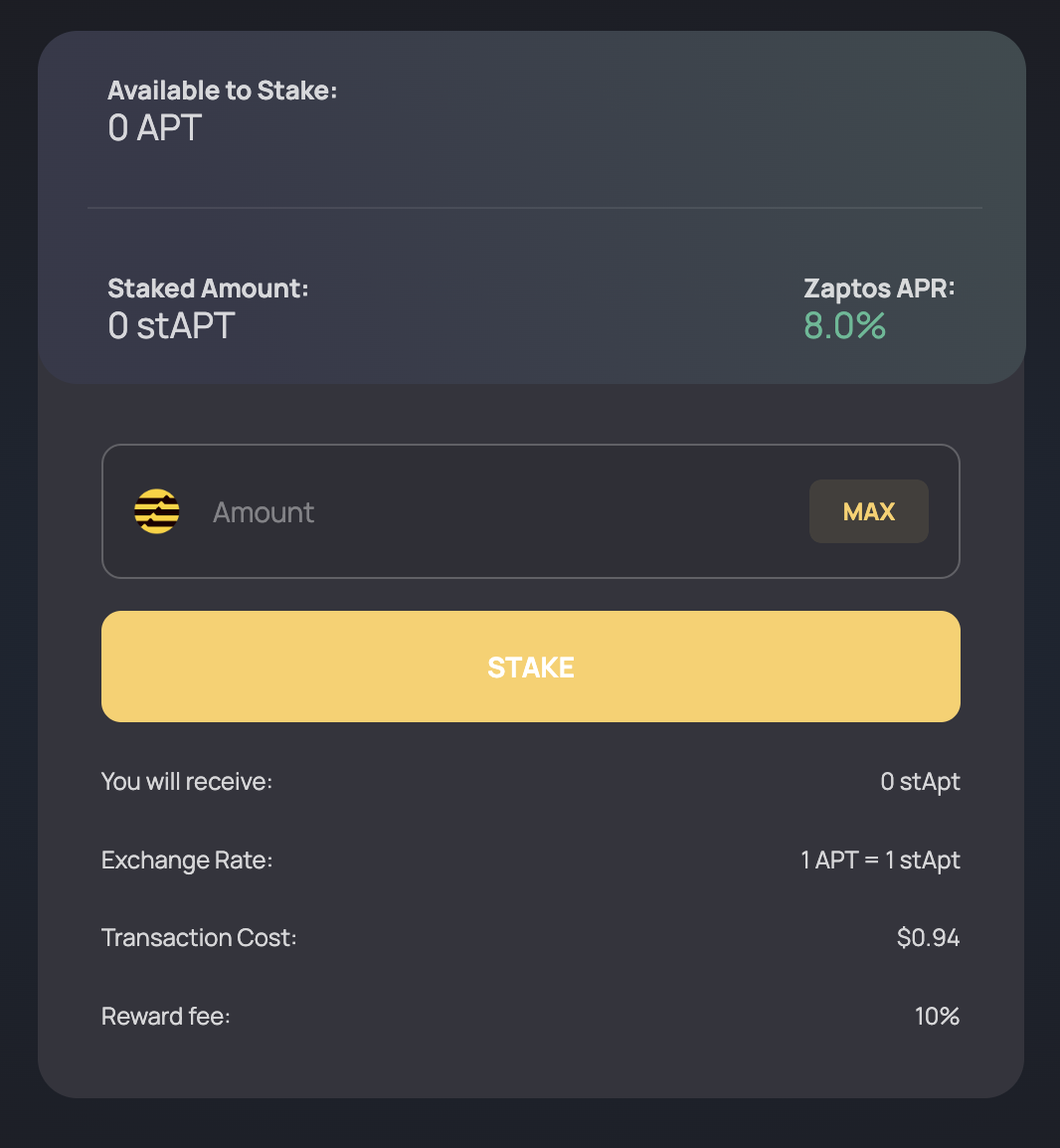
3. Four projects that are still concepts:
EMPO: https://twitter.com/Empo_Fi
EMPO aims to become a secure DEX on Aptos.
Ultima: https://twitter.com/ultimaprotocol
As the bronze medal winner of the Aptos hackathon, Ultima seeks to build a liquidity protocol in the Aptos ecosystem. There is no specific information about the project as it is not yet live.
Mover: https://twitter.com/moverxyz
Mover is a cross-chain project focusing on the EVM network and Aptos VM.
Meeiro: https://meeiro.xyz/
Meeiro is an IDO launchpad on Aptos that strives to help retail users invest in projects at an early stage.
II. DeFi
1. Vial: https://www.vial.fi/
Vial is a lending protocol built on Aptos that provides interest-rate lending services through liquidity pools. Its lending products have been launched on the testnet, and users can log in to the protocol through Martian and click on the faucet to get WBTC and USDC. At the moment, Vial supports three tokens: APT, WBTC and USDC, with an 8% deposit rate and a 10% borrowing rate. Right now, users can already deposit and lend cryptos on the protocol. That said, it has not yet achieved the algorithmic balancing of interest rates and is offering fixed rates.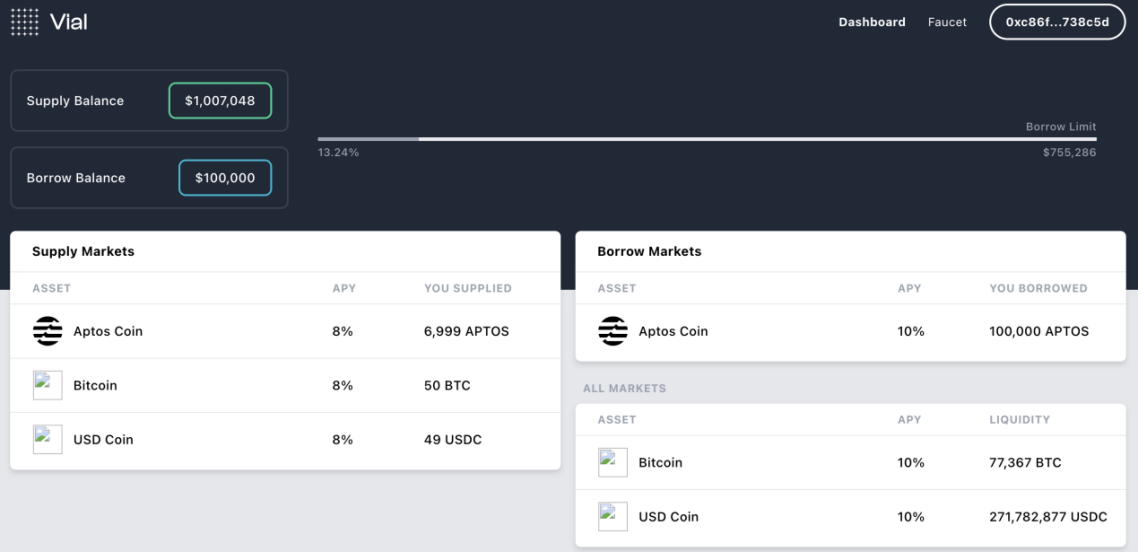
2. SEAM: https://www.seam.money/
SEAM is an aggregate earning project that allows users to earn returns from multiple protocols with one click. So far, the project has aggregated over 10 protocols, including Aries, EMPO, and names.Aptos, and created multiple pools that include CELO/ETH/USDC.
The project remains in its infancy, and its UI looks rough. Despite that, SEAM’s modular operations and the execution of contracts make users associate the project with Web 3 punk. If you are a tech geek, SEAM will definitely offer a great experience.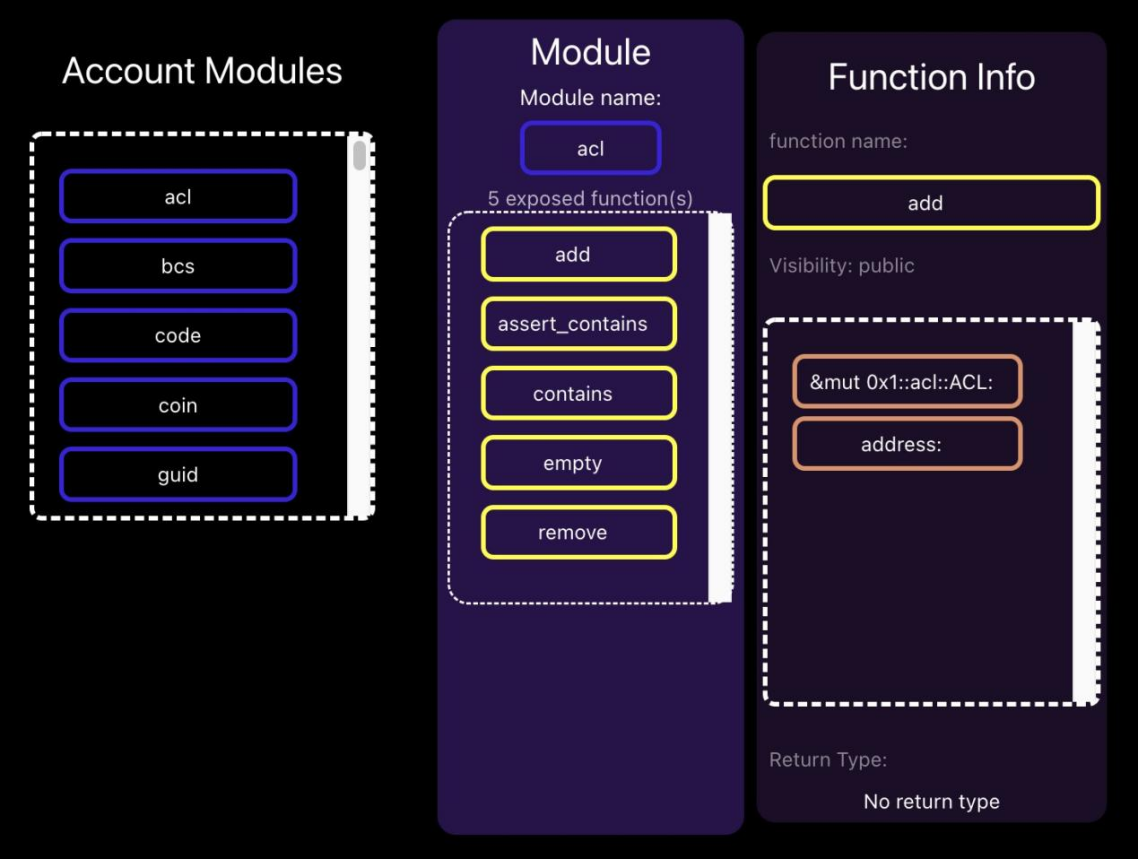
3. Pontem: https://pontem.network/
Pontem is an all-in-one protocol officially backed by Aptos. It raised $4.5 million during a seed funding round with investment from Delphi Ventures, Collider Ventures, Alameda, and Animoca at a very early stage. Pontem’s core motivation is to achieve interoperability between the Move-based Aptos and other public chains. Its product range now covers development tools for Move, a virtual machine infrastructure, a wallet, a cloud IDE, and a DEX protocol.
Pontem is a major infrastructure that’s now growing at a fast pace. Beginners often find it difficult to set up a compilation environment for Move. Additionally, most information now comes from Diem, a public chain developed by META. As such, during the programming process, developers often have to struggle with the outdated or unavailable language library. Pontem’s Move playground offers a great solution to such problems. This product is similar to WhiteMatrix’s chainIDE, which focuses on Diem, rather than Aptos or SUI.
Developers are the blood of a public chain ecosystem, and cloud-based IDEs represent a major infrastructure that appeals to developers. If Pontem could offer Move the same level of support as REMIX offers to Solidity, it would become a gathering place for Aptos developers, enabling the fast growth of the Aptos ecosystem. Right now, Pontem has started a new Ambassador Program. In 100 days, there have been over 1,000 applicants, and 235 registered Ambassadors completed 20 tasks. Meanwhile, liquidswap, Pontem’s liquidity protocol, has been launched on the Aptos testnet. Users can now get registered in Pontem wallet, click the faucet to receive APT, and collect BTC/USDT on the official website to interact with the protocol. At the moment, liquidswap has released functions that include Swap, Add Liquidity, and Create Pool.
4. Liquidswap: https://liquidswap.com/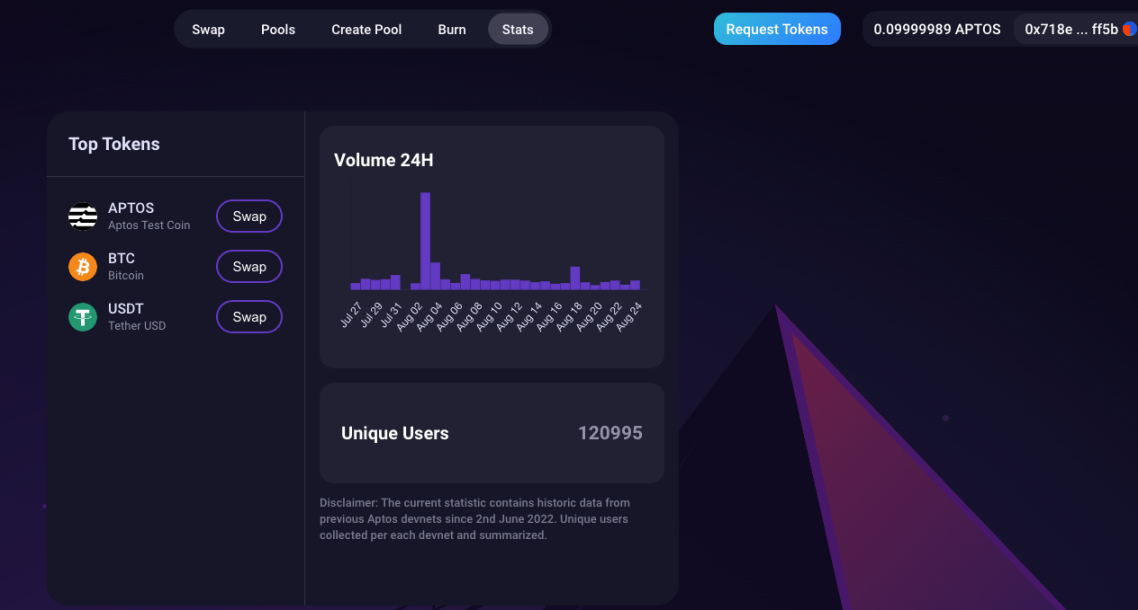
5. ARIES: https://ariesmarkets.xyz/
ARIES is a decentralized derivatives protocol on Aptos. It is also a margin trading platform that provides an on-chain order book. Focusing on interest-bearing loans and futures products, the project is making full development efforts. At the moment, the testnet API for ARIES is already available. The project is developer-friendly and open.
6.Aptin Finance:https://app.aptin.io/markets/
Aptin Finance is a lending protocol native to Aptos and has gone live on the testnet on September 3. Users can get connected and receive test tokens through the faucet. Aptin Finance is just like any other DeFi lending protocol: borrowers provide liquidity to earn interest, and lenders acquire liquidity by paying the interest. Right now, the testnet supports the lending of four types of tokens: APT, BTC, ETH, and USDT. At the moment, the deposit interest rate is fixed at 5%, and the borrowing interest rate is fixed at 6%.
Aptin will issue APN as its governance token to encourage users to provide more liquidity, and early liquidity providers can have the chance to collect token airdrops, which helped the project attract much attention over the recent period.
III. Data
Aptosphere: https://www.aptosphere.com/
Aptosphere is a real-time indexing protocol on Aptos. The project features an API interface that offers an easy-to-use port for project developers to acquire Aptos data. As an obscure project, Aptosphere has not disclosed much information.
IV. NFT
1. Topaz: https://www.topaz.so/
Topaz attracted decent traffic with its “complete tasks & earn NFT medals” campaign. As the leading NFT marketplace in the Aptos ecosystem, the project has integrated Martian, allowing users to freely create and trade NFTs. Topaz has introduced the two-week NFT medal program, and users can complete the required tasks and win medals. Over time, some creators have noticed Aptos’ NFT ecosystem and started creating NFT projects on the platform. Despite that, most such projects are copycats of blue-chip NFTs on Solana or Ethereum, and none of them are particularly impressive. Considering Aptos’ special support for SBT, we also look forward to more SBT-related projects on Aptos.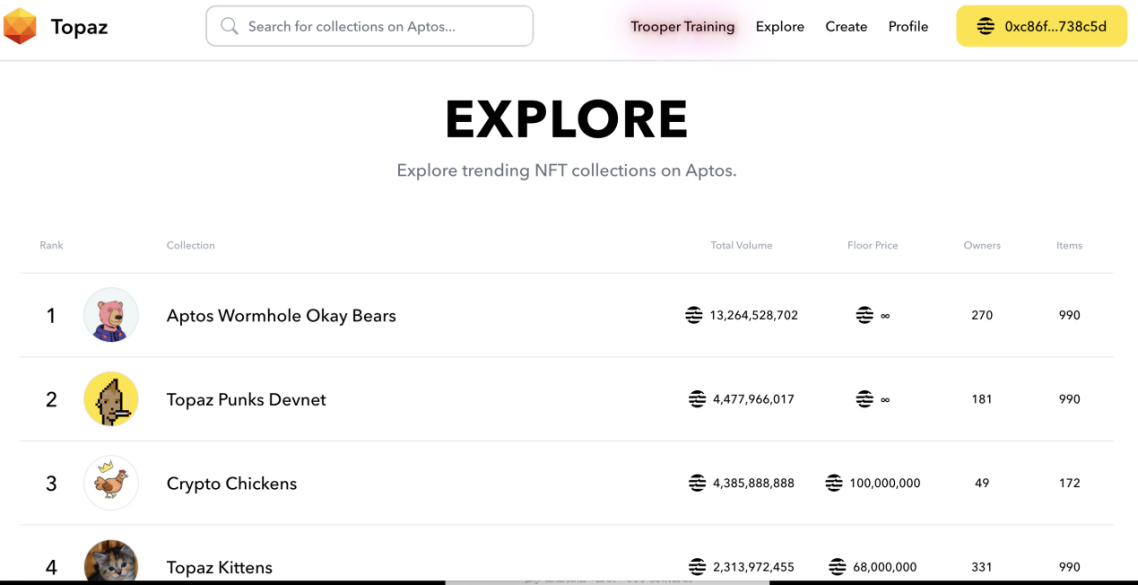
2. Aptos Name Service: https://www.aptosnames.com/
As its name implies, Aptos Name Service is an Aptos-powered domain name protocol. Users can spend a small gas fee on the testnet to mint a domain name NFT that they can use or trade through an NFT marketplace.
3. Souffl3: https://souffl3.com/
Souffl3,also an Aptos-based NFT marketplace, provides a series of NFT tools, including the tracking of on-chain NFTs. The project was migrated from Solana and recorded decent trading volume and user data on the previous chain. On Aptos, compared to other chains, it is easier for developers to shift from RUST to Move, so part of the project has already been implemented, and users can mint and trade test NFTs through the faucet. Souffl3 features one-click transaction and NFT tracking, which are both great functions.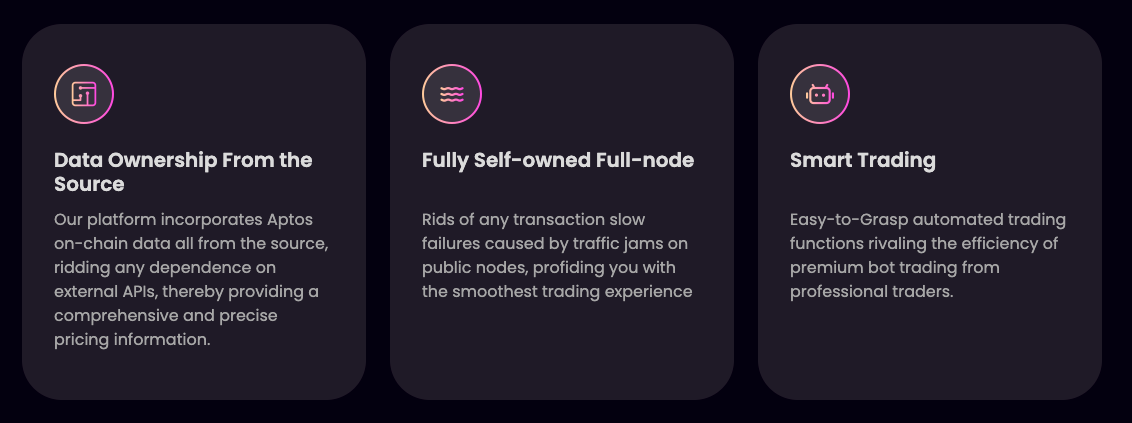
V. Games
1. Aptosport: https://aptosport.live/
Aptosport is a sports betting platform on Aptos that covers NBA, tennis, and football. Users can bet on their favorite teams or players to win rewards.
2. Aptos CODM: https://twitter.com/AptosCODM
Aptos CODM is a PUBG-like mobile game that hasn’t received much attention.
Hoping to seize the opportunity, a large number of projects have flocked to the emerging public chain Aptos. So far, infrastructures and DeFi applications are the most active projects in the Aptos ecosystem. In addition, NFT projects, which are most likely to attract regular users, are also a field of fierce competition on Aptos. Overall, Aptos’ roadmap resembles that of many other public chains. Besides, the chain has yet to present an impressive project. Most projects on Aptos were migrated from other public chains, especially Solana. The Aptos team has not fully tapped into the chain’s technical features and potential. Users and developers often regard Aptos as a promising new public chain. Surrounded by speculation and hyping, Aptos failed to deliver the features stated in its vision despite a lot of noise. We look forward to seeing more cornerstone projects on Aptos after the noises quieted down because they represent the true spirit of Aptos and carry this new public chain’s promise and future.



